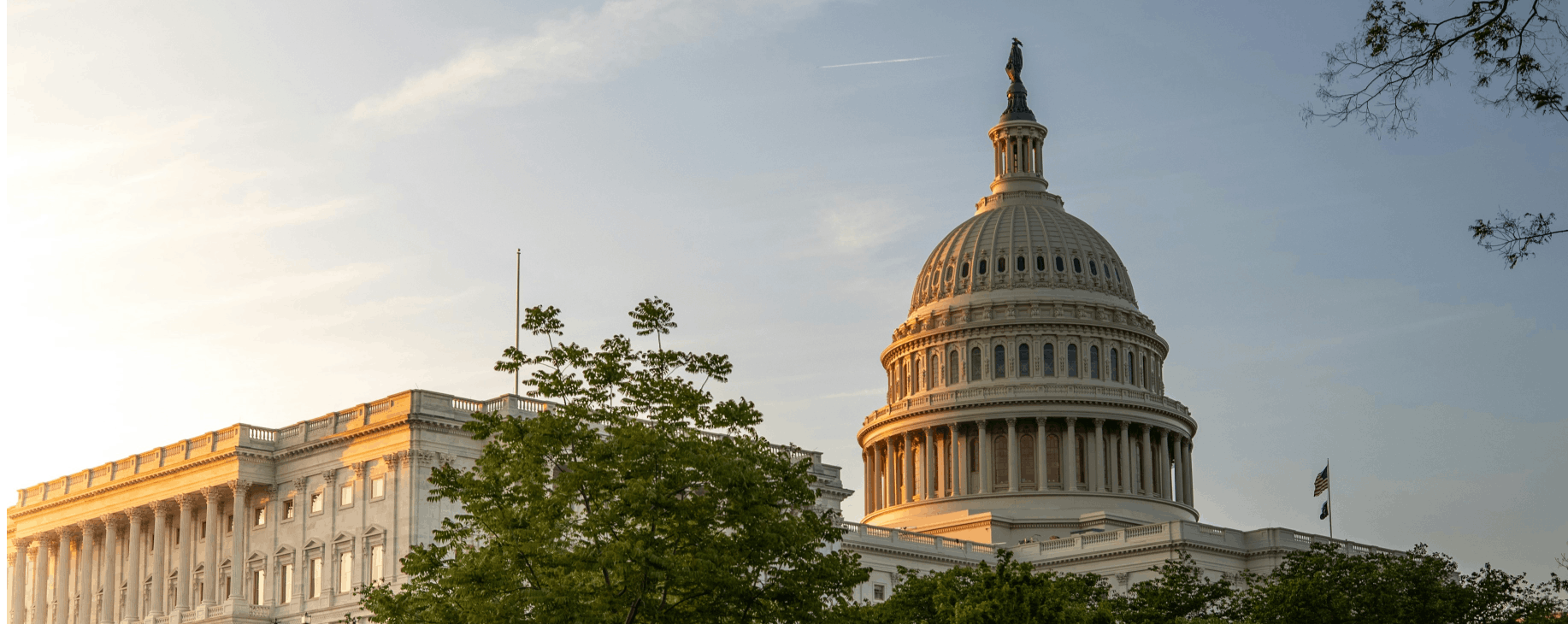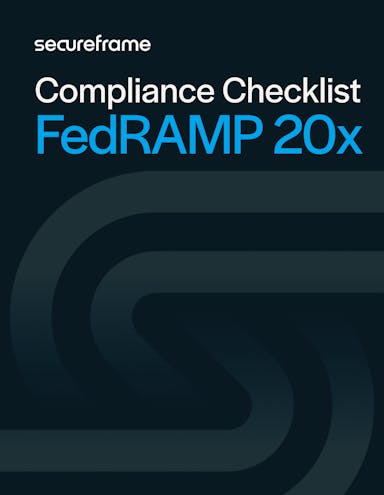
Navigating FedRAMP 20x: What The Changes Mean For Federal CSPs & How To Prepare
Emily Bonnie
Senior Content Marketing Manager
Rob Gutierrez
Senior Cybersecurity and Compliance Manager, CISA, CCSK, CMMC RP
Yesterday, the U.S. government announced sweeping changes to the FedRAMP program, marking one of the most significant overhauls to federal cloud security compliance in American history.
As the industry reacts to these changes, it’s worth taking a deeper look to understand what’s driving them. At its core, FedRAMP 20x is about improving and modernizing government technology, minimizing bureaucracy and accelerating cloud adoption, making it faster, easier, and more accessible for cloud service providers (CSPs) to achieve authorization and work with federal agencies.
With the transition to FedRAMP 20x already underway, CSPs must start preparing now. So, let’s unpack the core changes to the FedRAMP program, define exactly what they mean for your compliance strategy, and outline the steps you should take now to prepare.
What’s changing with FedRAMP 20x?
FedRAMP 20x is more than just an update, it’s a fundamental transformation of how federal cloud security compliance works. The new framework is designed to clear bottlenecks, reduce paperwork, and make compliance more efficient and accessible through automation, self-attestation, and real-time security monitoring.
Instead of point in time checks and annual assessments, CSPs will now need to adopt a continuous compliance mindset. Let’s examine the key changes and what they mean for CSPs.
Transition to automation-driven compliance
One of the biggest changes in FedRAMP 20x is the shift to real-time security tracking.
Instead of undergoing annual security assessments, CSPs will now track and report security changes in real time through automated tools. Agencies will be able to approve or modify these security updates through a dashboard rather than waiting for scheduled reviews. This will allow agencies to react to security risks in real time instead of waiting for formal review cycles, and enable CSPs to innovate faster without hitting compliance bottlenecks.
For CSPs, automation is no longer optional — it is a requirement for maintaining FedRAMP compliance. While specific tools are still being evaluated, CSPs can start preparing their systems and personnel now. Begin by assessing your current compliance processes:
- Which manual compliance tasks are time-consuming or prone to human error?
- Where are the biggest inefficiencies in your security and reporting workflows?
- What processes require repetitive documentation or frequent updates?
Tasks such as evidence collection, control validation, document management, and vulnerability scanning are typically high-impact areas for automation. By identifying these opportunities now, CSPs can streamline their compliance workflows and position themselves for a smoother transition to FedRAMP 20x.
Self-attestations rather than annual assessments
In the future, the goal is to streamline the review process and reduce the number of assessments by relying on automated tools and agreed-upon industry standards to verify and report security compliance. For example, instead of describing encryption settings within a document, a real-time API would confirm that all storage systems are encrypted via an OSCAL JSON or XML file.
This also means the role of Third-Party Assessment Organizations (3PAOs) is evolving. Auditors will still be authorizing audits until the new program is implemented, and they may still be involved for FedRAMP Moderate and High authorizations. Or, their role may shift to certifying compliance automation tools, verifying automated security processes, or acting as technical advisors to agencies interpreting real-time security reports. The Automation Assessment and Reporting Working Group will ultimately determine how 3PAOs fit into the new compliance landscape.
This change ultimately means two things for CSPs. First, self-attestation means fewer manual security assessments and less reliance on 3PAOs for annual audits. By eliminating redundant documentation and replacing it with automated compliance verification, CSPs will save time and resources.
But this shift also puts more responsibility onto the CSP’s security teams, who must prepare to self-attest and continuously monitor their security posture. Compliance will be an ongoing process that requires strategic and proactive risk management.
Faster authorization timelines
One of the biggest pain points in the current FedRAMP process is the long wait time for authorizations, which often exceed one year. With FedRAMP 20x, the government is committing to clearing the existing backlog by April 2025 and reducing future authorization processing times to under two weeks.
For CSPs, this means faster access to federal market opportunities. However, with shorter timelines, organizations need to be fully prepared to meet the new compliance requirements before they apply for authorization.
Lower compliance costs
Another major barrier to FedRAMP authorization has historically been cost. Under the current model, CSPs must spend between $75,000 - $200,000 on 3PAO assessments, not to mention the additional costs of preparing extensive compliance documentation and undergoing agency reviews. These expenses have made FedRAMP prohibitively expensive for smaller and mid-size cloud providers, limiting competition and slowing federal cloud adoption.
Moving to a self-attestation model significantly reduces compliance costs, making FedRAMP more financially accessible to a broader range of CSPs. While automation tools and implementation will still require some initial investment, this shift levels the playing field and allows companies that previously couldn’t justify the cost of FedRAMP compliance to enter the federal market.
Greater flexibility in security practices
Unlike previous versions of FedRAMP, which prescribed exact security requirements, FedRAMP 20x is shifting toward a more flexible, industry-driven approach. Moving forward, FedRAMP will rely on industry working groups that include stakeholders across cloud service providers, compliance automation tools, and government agencies, to collaboratively define standards, improve automation processes for assessments and reporting, and establish ongoing channels for industry-agency collaboration.
Instead of following a rigid compliance checklist, CSPs will be able to develop security controls that align with their unique architectures, as long as they meet baseline security standards and receive agency approval.
This approach is intended to encourage faster innovation and more efficient security processes, but it also means CSPs must take ownership of how they implement and demonstrate compliance.

FedRAMP 20x Low Compliance Checklist
Participants in the FedRAMP 20x Phase One pilot seeking FedRAMP Low authorization must apply all Key Security Indicators (KSIs) to all aspects of their cloud service offering. Use this checklist listing all KSIs and their underlying NIST 800-53 controls to evaluate your compliance status.
Stronger alignment with industry security certifications
Another major change is the move away from FedRAMP-specific documentation. While NIST 800-53 will still serve as a reference framework, FedRAMP 20x will potentially allow CSPs to demonstrate compliance using widely accepted industry certifications such as SOC 2 reports and ISO 27001 certifications. There is also a shift to standardized security attestations rather than agency-specific security questionnaires.
This change eliminates unnecessary paperwork and encourages stronger alignment with commercial security practices, meanwhile reducing compliance costs for CSPs and making it easier for companies that already meet industry best practices to obtain and maintain FedRAMP authorization. Ultimately, this will also help make the American government more modernized and efficient using technology that is available today.
CSPs that haven’t pursued industry-standard certifications will need to start aligning their security programs accordingly.
Closer collaboration between agencies and CSPs
FedRAMP will no longer act as the primary intermediary between agencies and CSPs. Instead, FedRAMP is shifting to a marketplace model where federal agencies will engage directly with CSPs for security assessments, approvals, and ongoing monitoring. While FedRAMP will still issue authorizations, the majority of compliance interactions will occur between agencies and cloud providers.
FedRAMP 20x will also likely eliminate the need for CSPs to submit SCRs for most updates. By 2026, agencies are expected to self-certify security updates based on direct visibility into CSP security dashboards, eliminating the need for FedRAMP to manually review updates.
For CSPs, building stronger direct relationships with federal agencies is now essential. Lay the groundwork now for clear, transparent reporting mechanisms that can provide agencies with real-time security updates and maintain trust. CSPs will also need to engage proactively with agency security teams to understand their evolving expectations under the new model and ensure their compliance strategy aligns with the agency’s needs.
Incremental rollout and annual updates
Unlike previous FedRAMP updates, which were large-scale, infrequent regulatory overhauls, FedRAMP 20x introduces an annual update cycle much like a software release model. Future iterations, such as FedRAMP 2026, will refine security requirements to align with emerging threats and evolving industry best practices.
Because FedRAMP will now update security requirements annually, CSPs must remain agile and be prepared for continuous updates to security policies, automation standards, and compliance expectations.

7 Steps CSPs should take now to prepare for compliance with FedRAMP 20x
With the transition already underway, CSPs need to take action now to ensure they’re prepared for the new compliance model. Below, we outline key steps that will help CSPs stay ahead of the curve.
1. Get ready to implement compliance automation
While specific automation tools are still being evaluated, CSPs can take some practical steps to prepare for adopting a tool now.
For example, many automation tools will rely on APIs to collect security and compliance data from cloud infrastructure. CSPs should evaluate their existing APIs for logging, security monitoring, and control validation to ensure they can support real-time data collection. If gaps exist, organizations should begin developing API integrations to connect security tools, SIEMs, and compliance platforms.
Another key area of focus is standardizing security and compliance logs. Automation platforms will pull data from logs, security events, and system configurations to verify compliance in real time. CSPs should ensure these logs are structured, complete, and stored in platforms like AWS CloudTrail, Azure Monitor, or a SIEM solution.
2. Prepare for continuous monitoring and self-attestation
With the shift away from manual audits, CSPs need to ensure that their security configurations are verifiable through APIs and automated compliance tools. Conduct an internal assessment of your existing security practices and determine where and how you can integrate automated validation checks at any given point in time.
3. Adjust compliance processes for faster authorizations
As FedRAMP transitions to a two-week authorization timeline, CSPs should prepare for a more agile compliance workflow. This means ensuring internal security policies align with FedRAMP’s automated reporting requirements and that compliance teams are ready to interact directly with agencies whenever needed.
4. Develop agile security strategies
With greater autonomy regarding security controls, CSPs should review their existing compliance frameworks and identify opportunities to enhance their security posture in a way that best fits their specific architecture. Moving away from rigid compliance checklists allows CSPs to implement security practices that align with industry best practices, specific customer requirements, and their own unique systems and business objectives.
5. Align with industry security certifications
CSPs should prioritize obtaining or maintaining security certifications such as SOC 2 and ISO 27001, as these will serve as key indicators of security compliance. Organizations already holding these certifications will experience a smoother transition to FedRAMP 20x.
6. Strengthen agency relationships
With FedRAMP stepping back from direct oversight, CSPs will need to engage more closely with federal agencies. Establishing strong communication channels with agency security teams will be critical to navigating the new compliance landscape effectively and efficiently.
7. Plan for change
The details of FedRAMP 20x are still being finalized, and a lot can (and will) change over the coming months as industry groups convene and iron out details. But even when exact processes and requirements are determined, the FedRAMP program is now intentionally designed for change.
Since FedRAMP will now update security requirements annually, CSPs must remain agile and build adaptability into their compliance programs. This includes monitoring FedRAMP updates and ensuring that security policies evolve in alignment with regulatory changes.
The shift to automation signals the future of security and compliance
At its core, FedRAMP 20x signals a fundamental shift in how security and compliance are managed, moving away from static, point-in-time assessments toward continuous monitoring and automation. This is more than just a framework update — it’s a recognition that federal security compliance needs to be lighter, faster, and more adaptive.
For those of us who have long championed automation in security and compliance, this shift isn’t surprising. It’s inevitable.
Threats evolve in real time, and security measures must evolve with them. Regulatory bodies, enterprises, and entire industries are recognizing that traditional compliance models are no longer sufficient. Organizations that proactively adopt automation will lead the way in this new era of compliance.
Secureframe has helped thousands of organizations leverage the power of real-time security insights, automated control validation, and continuous compliance to drive better security outcomes while improving operational efficiency. Our customers have experienced the benefits of streamlined audits and stronger security postures, with an average 27% reduction in annual compliance costs.
Navigating a shifting compliance landscape can be complex, but Secureframe simplifies the process with a compliance automation platform designed to help organizations achieve, maintain, and continuously monitor their security posture. With deep expertise in federal compliance, seamless integrations, and AI-powered risk management, Secureframe makes meeting FedRAMP 20x requirements simple.
- Expert guidance from federal compliance specialists: Our team includes former FedRAMP, FISMA, and CMMC auditors who provide hands-on support throughout your compliance journey. From initial scoping to readiness assessments, we can help ensure your CSP satisfies FedRAMP requirements.
- Deep integrations with federal cloud services: Secureframe automates evidence collection and continuous monitoring by integrating with AWS GovCloud and other federal cloud environments, ensuring ongoing compliance and eliminating manual effort.
- Continuous control monitoring and validation: Our platform continuously monitors your tech stack to detect vulnerabilities and misconfigurations. Set custom test intervals and notifications for required compliance tasks, ensuring you maintain a strong security posture over time.
- Third-party risk management: Secureframe’s Risk Management capabilities help you track, assess, and mitigate security risks. Automate third-party risk assessments to ensure vendors align with FedRAMP’s supply chain risk management requirements.
- Cross-mapping controls across frameworks: Secureframe simplifies multi-framework compliance by automatically mapping controls across 40+ frameworks, including other federal standards such as NIST 800-53, NIST 800-171, CMMC 2.0, and CJIS.
- Trusted partner network: Our relationships with C3PAOs, vCISOs, MSPs, MSSPS, and other trusted service partners can help further streamline FedRAMP readiness and audits.
- Document and policy management: Fully customizable policy, procedure, and SSP templates written by former federal auditors can be fully tailored to meet your needs. Our enterprise policy management capabilities include POA&M documents, impact assessments, and readiness reports. We're also adding a review and approval workflow for policies, which is a FedRAMP requirement.
- Customizable Trust Center: Demonstrate a strong security and compliance posture, build trust, and differentiate yourself from competitors with a fully customizable Trust Center.
Connect with our team to learn more about how Secureframe can support your FedRAMP 20x compliance and automate your security operations.
Use trust to accelerate growth

Emily Bonnie
Senior Content Marketing Manager
Emily Bonnie is a seasoned digital marketing strategist with over ten years of experience creating content that attracts, engages, and converts for leading SaaS companies. At Secureframe, she helps demystify complex governance, risk, and compliance (GRC) topics, turning technical frameworks and regulations into accessible, actionable guidance. Her work aims to empower organizations of all sizes to strengthen their security posture, streamline compliance, and build lasting trust with customers.

Rob Gutierrez
Senior Cybersecurity and Compliance Manager, CISA, CCSK, CMMC RP
Rob Gutierrez is an information security leader with nearly a decade of experience in GRC, IT audit, cybersecurity, FedRAMP, cloud, and supply chain assessments. As a former auditor and security consultant, Rob performed and managed CMMC, FedRAMP, FISMA, and other security and regulatory audits. At Secureframe, he’s helped hundreds of customers achieve compliance with federal and commercial frameworks, including NIST 800-171, NIST 800-53, FedRAMP, CMMC, SOC 2, and ISO 27001.